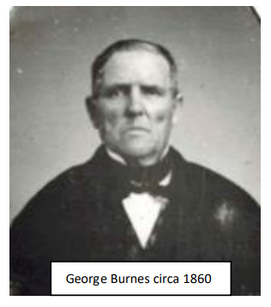This history lesson comes from one of our newsletters. Newsletters are a benefit of membership with the Hopkins Historical Society. Learn more here: |
George McCoy Burnes
‘A man ahead of his time.’
by Mary Raabe
first published in 2018
|
Have you ever enjoyed a day in Burnes Park and wondered about the origin of the name? Who was this Hopkins notable honored with a park and a street bearing the name Burnes?
Our history of George Burnes begins with an arduous seven day journey in 1854. He and his wife Amelia and 5 children (Catherine, Diana, John, George and Charles) left Taunton, Massachusetts for western Hennepin County. Our records do not show exactly why he left Massachusetts, but it was during the time of Horace Greeley and skilled workers were leaving this new world of urbanization and industrialization to travel “West where every man had his right to a bit of land”. George Burnes was a mechanic and a good one, but he was only making $2 a day in Taunton. He might have been looking for a life of greater promise. Whatever the reason, Hopkins was most certainly the beneficiary of his decision. After living in three Hopkins area locations, Burnes bought acreage and built a spacious 17 room house on the Campbell Farm, now Hobby Acres. Five years later, in 1866, he moved his house 700 feet to a permanent location just south of Minnetonka Mills Road and the current Althea Lane. There it stayed for over 70 years. By now, his contributions to Hopkins were well underway. In 1861 he purchased land on the east end and donated the site for Hopkins’ first school. Before the Burnes school opened, the family living room served as the first real school in Hopkins. Any child was welcome and Mrs. Burnes was eager to teach. The Burnes’ living room was a busy place in those early days and almost always in demand. Their grand house was home to the first piano in Hopkins. Their large living room served as a venue for both Minneapolis and local musical talent. The popular ensemble of Diana Burnes, John Burnes, James Maloney and Frank Miller playing the piano, flute and two violins was a sought after evening in Hopkins. |
Mr. Burnes was active in area politics and was treasurer of Minnetonka Township which then included Hopkins. Many planning sessions were held in the Burnes living room. Burnes also hosted meetings of the Athenaeum Club where he was a charter member and a founder of the Minneapolis Public Library.
George Burnes was a prosperous and innovative farmer with a well known herd of cattle. He provided milk and beef for area residents, perfecting the tools to quarter beef. He brought the first steam thresher to Hopkins and harvested crops with other area farmers. He owned a blacksmith shop in Minnetonka and ran a general repair shop from his barn, serving farmers from miles around. He was a master of all things mechanical. It was said, when his house was razed in 1939, it was built so sturdily with fitted, mortised joints, ordinary wrecking methods failed to work. In the 1870s, George Burnes tragically died at the young age of 47, while working at his thresher. Sadly, he died before he could see all his children reach adulthood, but we know he would have been proud – two college graduates, Catherine and Diana, and four sons John, George, Charles and Oliver. While not as prominent as their sisters, his sons still contributed to the growth and vitality of Hopkins. In the words of great great grandson Bruce Burnes: “The legacy of George Burnes exists beyond the grave. Burnes Park & Burnes Drive are living reminders of his contributions to Hopkins. His ideas of farming, culture and education were unusual for a mid-nineteenth century male in rural America. He truly was a man ahead of his time.” |
Burnes Family History Acknowledgements
Hennepin County Review
Minneapolis Tribune
Minneapolis Journal
Minneapolis StarPioneer
Physicians in Hopkins, a memoir by Jeanette Blake
Burnes Family Reunion, by Bruce Burnes Remembering, A book about the Burnes family by Clint and Dot Burnes
Hennepin County Review
Minneapolis Tribune
Minneapolis Journal
Minneapolis StarPioneer
Physicians in Hopkins, a memoir by Jeanette Blake
Burnes Family Reunion, by Bruce Burnes Remembering, A book about the Burnes family by Clint and Dot Burnes

